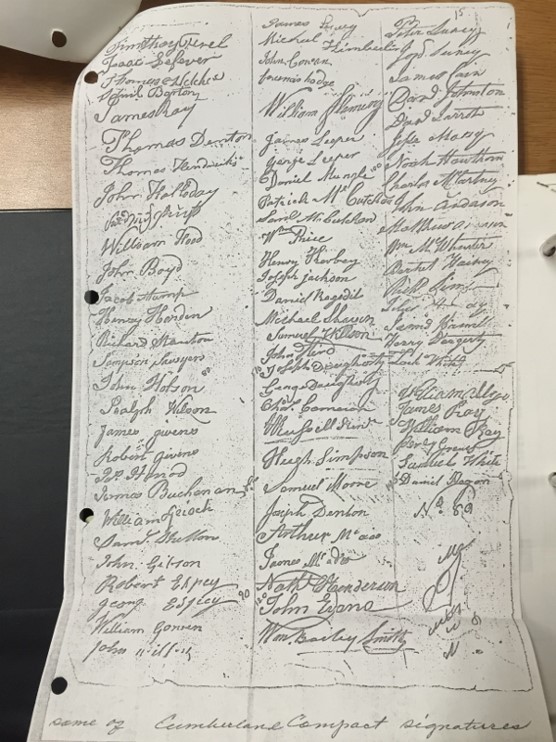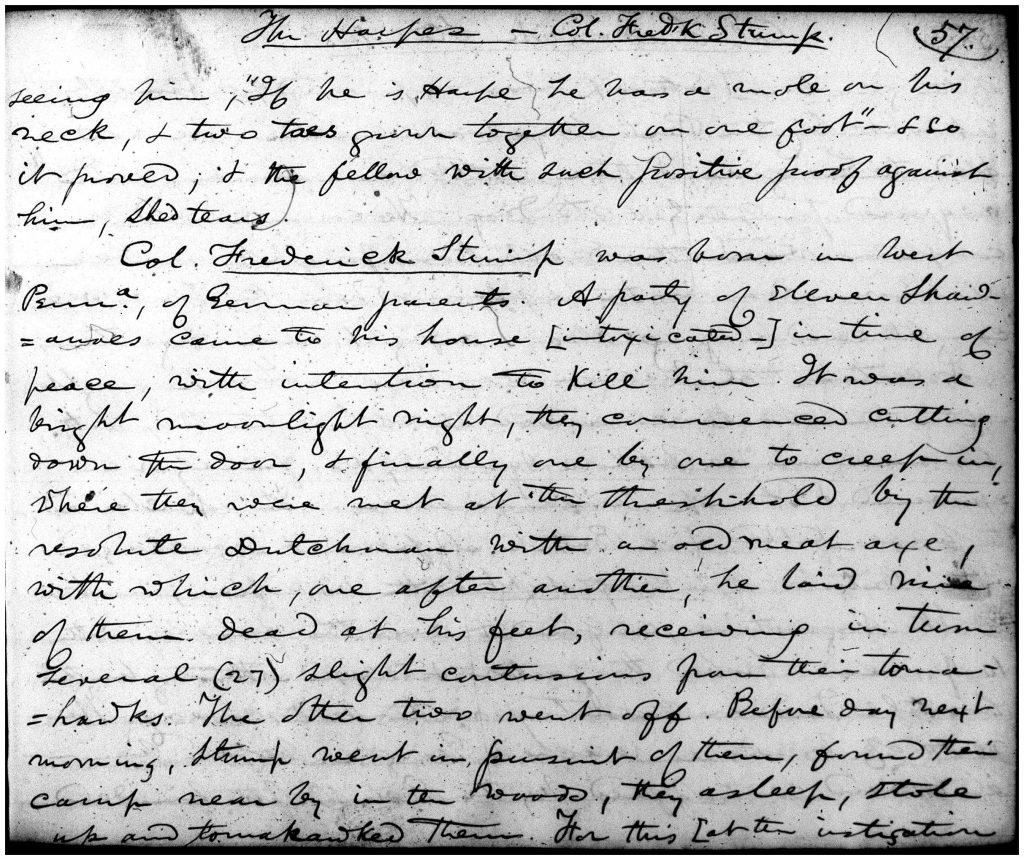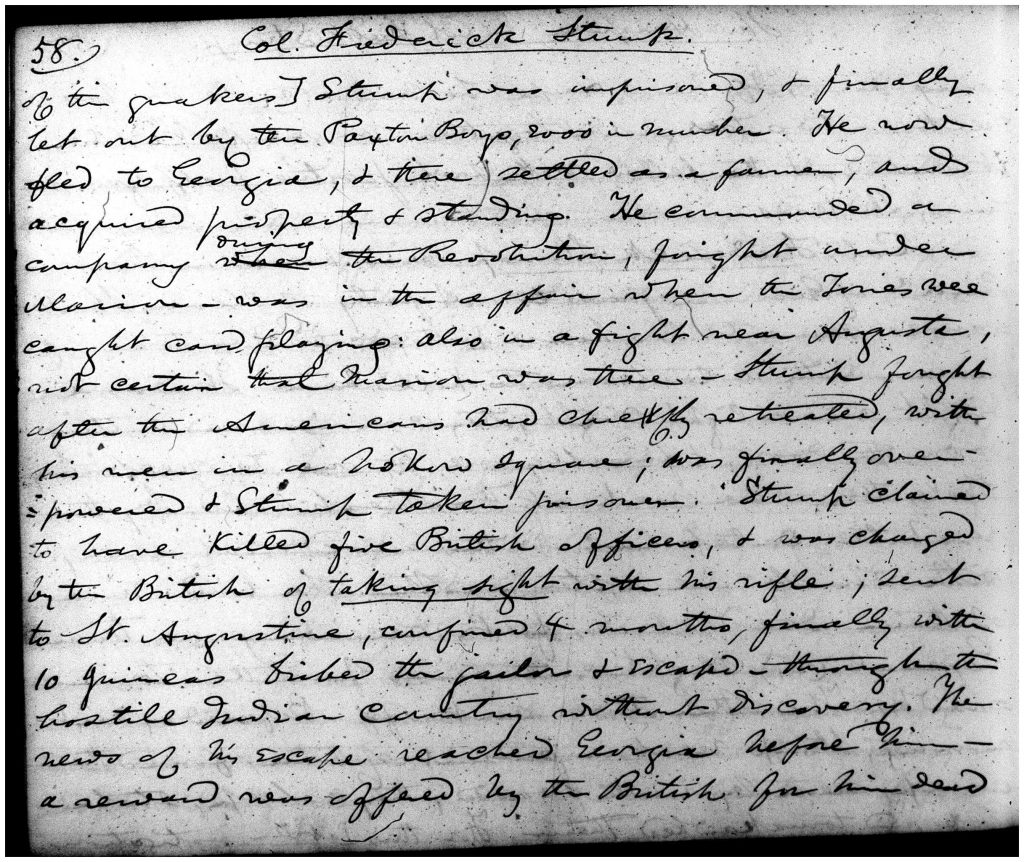The mystery surrounding the Stump Massacre is one that scholars, local enthusiasts, and curious youngsters have contemplated in the years since the massacre, with the majority of attention being paid to it in the twentieth century. Yet, no one knows why Stump and Ironcutter chose to kill ten Native Americans or to where the two men disappeared.World War I-era article by Charles Edwin about Stump’s Massacre and Stump’s alleged escape to freedom

Some scholars, such as Charles Edwin and Linda Ries, maintain that Stump escaped to Virginia after his rescue from Carlisle Jail and lived the rest of his life there. John Franklin Meginness wrote that Stump hid at his father’s house near Tulpehocken before stealing away to Virginia. Ironcutter, in Meginness’ tale, was “secreted by some of his friends.” However, as time went on and new scholars began to pick up the story, claims began to circulate that Stump had in fact made his way to Tennessee. Interested people began to make connections between Frederick Stump the “Indian Killer” and a Frederick Stump that appeared as a founding member of Cumberland County, Tennessee.
Enter Julia Cook Guice. Guice wrote the book Frederick Stump: The Rest of the Story. She noted with surprise that Pennsylvania historians had lost Stump’s trail after the escape from jail. Tennessee historians, on the other hand knew that Stump laid down roots in the South. After all, Guice wrote, “Frederick did not hide his sordid past; he told all that would listen.” Despite such apparent widespread discussion of the murders along the Cumberland, Guice had only one true source for this information: the “smoking guns” for Guice were a pair of connections that seemed to knit the two chronologies together. First, Guice pointed to the words of John Stump, who, when interviewed by Lyman Draper in the 1830s (see below), said that his father had killed Native Americans in Pennsylvania decades earlier. Second, Guice found similarities in the signatures of the Fredericksburg, Pennsylvania Frederick Stump and the Cumberland (TN) Compact Frederick Stump.
In a vivid example of the slipperiness of the Stump narrative, Guice claimed that the “tall tales” about her ancestor rested on the Pennsylvania side of the story. She seemingly accepted without any doubt the link between the two Frederick Stumps.
Guice claims that Stump and Ironcutter went north after their escape from Carlisle, “brazenly concealed for a short time in the Fort Augusta area.” Guice followed the lead of John Blair Linn on this point, while noting that Linn provided “no original material.” After staying in the vicinity of the Fort for a while, Guice claimed, Stump went to his father’s house in Tulpehocken before fleeing southward.
She picked up the action in Georgia, without demonstrating how she connected the man who killed ten people on Middle Creek with the man who “settled on the lands of the Creek and Cherokee Indians near Augusta and made many improvements.” It’s hard to know just what to make of these claims; Guice included stories in her book that she described as “interesting but questionable.” She referred to “clear” and “obvious” facts without providing any documentation.
The source of the connection between the Middle Creek, Pennsylvania, Frederick Stump and the Whites Creek, Tennessee, Frederick Stump is the collected notes of the Wisconsin historian Lyman Draper. In the 1830s and 1840s, Draper researched the lives of many white settlers to the southern frontier of Kentucky, Tennessee, and Virginia. In the absence of other written records, Draper interviewed first-generation European-American settlers and their descendants to document early frontier life. One of those descendants was a Colonel John Stump, son of Tennessee’s Frederick Stump. The story that Draper recorded from John Stump’s interview framed Frederick Stump as frontier hero:
A party of eleven Shawnees came to his home (intoxicated) in time of peace, with intention to kill him. It was a bright moonlight [sic] night, they commenced cutting down the door, & finally one by one to creep in, where they were met at the threshold by the resolute Dutchman with an old meat axe, with which, one after another, he laid nine of them dead at his feet, receiving in turn several (27) slight contusions from their tomahawks. The other two went off. Before day next morning, Stump went in pursuit of them, found their camp nearby in the woods, they asleep, stole up and tomahawked them.
The villains in Draper’s narrative? Besides the murdered Native Americans, the Colonial Government of Pennsylvania played the role of the bad guys. Draper noted that Stump’s capture came “at the instigation of the Quakers.” Long-standing ethnic divisions still held power in the 1840s, so it would have been easy for Col. John Stump to believe that his father had been unfairly arrested at the whims of pacifist Quakers. Draper’s version of the story ended happily, at least from John Stump’s perspective. “The Paxton Boys, 2000 in number” freed Stump, who “fled to Georgia & there settled as a farmer.”
Draper’s notes take Stump from Georgia to Tennessee, via a commanding position in the Revolutionary War, an imprisonment by the British in Saint Augustine, Florida, and an escape “through the hostile Indian country without discovery.” With his property destroyed or confiscated by the British, Stump fled to Tennessee, settling on Whites Creek by 1779. One document that picks up the Tennessee connection is the Cumberland Compact. In May of 1780, 250 frontiersman convened along the Cumberland River at Fort Nashboro (near present-day Nashville, TN) in order to craft this formal constitution for their budding community. The Compact established governmental procedures for addressing issues such as land transactions and the need for a militia. Among the signees of the Compact was one Frederick Stump.

Though rumored to have settled in this area, it is not clear if this was the Frederick Stump of Middle Creek. On the one hand, the story told by John Stump certainly echoed the events of January 1768. On the other hand, some of the details contradict key facts from Pennsylvania colonial officials. Draper ended his notes on Stump this way: “Col. Stump died in May 1822, aged 98.” That would date his birth to the years 1723-4, which is twelve or thirteen years earlier than colonial officials asserted in their description of the fugitive. Furthermore, the Nashville Whig dates the death of Frederick Stump of Whites Creek to May 1820.
And as for John Ironcutter? Authors from the Snyder County Historical Society suggest that Ironcutter managed to spend the rest of his life in Snyder County, living well into his nineties. None of these theories can be definitively confirmed.
As for the events of the night of January 10, 1768, we can’t know what was going through Stump’s mind. Was it self-defense, a drunken brawl gone horribly wrong, or a cold and calculating plot for vengance? Was he an innocent man pushed too far or an “audacious criminal,” as the Pennsylvania Governor called him eleven days after the deaths?

Stump’s informal confession before the crowd gathered at George Gabriel’s house claimed that the Native Americans “came to his (Stump’s) House, and being in Drink and Disorderly, he endeavoured to persuade them to leave his House, which they were not inclined to do, and he being apprehensive that they intended to do him some Mischief, killed them all.” However, some twentieth-century sources promote the idea that Stump sought to avenge the deaths of his wife and children, who were supposedly killed by Native Americans in Lancaster County. There was a Frederick Stump who lived in Lancaster County in the late eighteenth century (and founded the town of Fredericksburg in 1754), but this was not the Stump of Middle Creek. Historian William Henry Egle noted in 1883 that the Lancaster Stump died in Lancaster County before the Revolution and was an “industrious farmer” and “enterprising citizen.” Of course, even such a straightforward observation can be cast into doubt when other details test the researcher’s confidence. Egle referred to the Stump Massacre as “the atrocious murder of several Indians near Carlisle at the close of the French and Indian War.”
To add a further twist to the family angle, the Minutes of the Provincial Council from January 19, 1768 state that Blyth made the Council believe that Stump was “with his family” in the cabin on Middle Creek. No mention is made elsewhere of anyone but Ironcutter living with Stump on Middle Creek.

